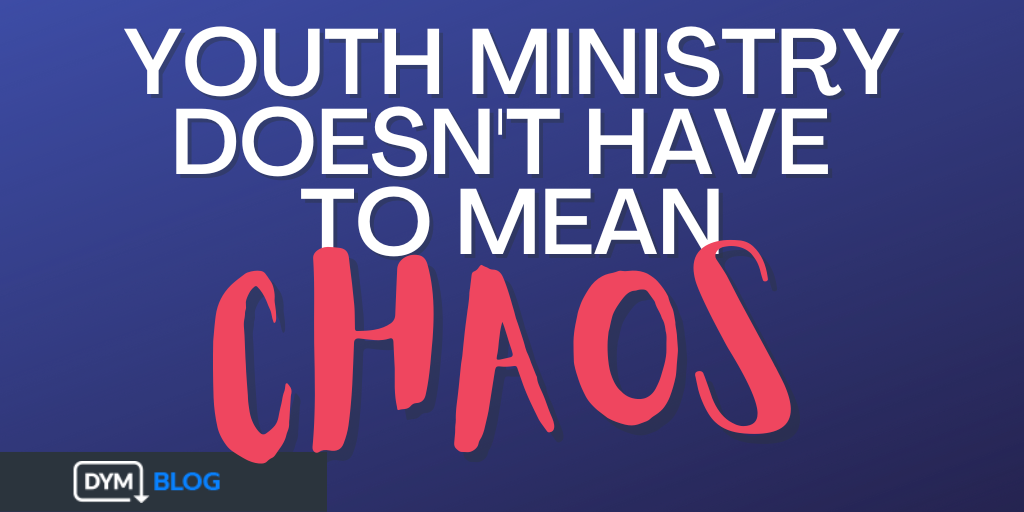
Maybe you’ve heard, but youth pastors have a bit of a reputation for being disorganized and for flying by the seats of our collective pants.
In short, structure is generally not our greatest strength.
Although it’s not easy, when we work to provide structure to our ministries, we are doing our students, our volunteers, and ourselves a huge favor.
// YOUR STUDENTS NEED STRUCTURE
Although it may sound cliché, our students need structure.
- STRUCTURE PROVIDES SAFETY– Many students come from homes that aren’t super stable. So, when we can provide a few hours each week where students exist in a familiar environment, see familiar faces, and experience a familiar flow to the evening, we’re often giving our students a gift that they didn’t even know they needed.
- STRUCTURE MAKES INVITING FRIENDS A LOT EASIER– For students, inviting someone to youth group is a huge risk, and I’ve realized that students are WAY more likely to invite their friends to something when they generally know what to expect. Adding a bit of structure to your weekly program helps students have an answer when their friends ask them, “what are we going to do while we’re there?”
- STRUCTURE HELPS STUDENTS KNOW WHAT’S EXPECTED OF THEM– Are you having difficulty getting students to quiet down during the teaching time? Or maybe your students keep arriving later and later? I’d suggest setting a schedule and sticking to it. After a while, they’ll start getting used to the idea that “we start at 7pm” or “after worship, it’s time to find a seat and engage the lesson.” Remember, students can’t meet your expectations if they don’t know what they are. And structure just helps make those expectations a bit clearer.
// YOUR VOLUNTEERS NEED STRUCTURE
Recently, I was talking to a potential volunteer when they asked, “If I volunteer on Wednesday night, what time will I be able to head home?” The only problem was that I couldn’t answer the question because we hadn’t ever set a firm time that youth group officially ended. Honestly, we’d just wait until all of our students left, and then the adults would lock up and head home, usually somewhere between 10:00pm and 10:30pm (though sometimes as early as 9:15pm or as late as 11:00pm).
We have always operated under the thought that “we’d rather them hang out here than get into trouble somewhere else.” The only problem is that without a structured end on Wednesday nights, we were burning out our current volunteers and making it more difficult to recruit new ones.
Although we haven’t quite solved it yet, we have started taking steps in the right direction. Our volunteer clean-up crew now starts cleaning up at 9:15pm, and we ask any students who are still hanging around to help. Our goal is to get to a point where we can tell our volunteers (and potential volunteers) that on a “typical” Wednesday, they can expect to leave around 9:30pm. In the long run, I’m hopeful that establishing structure at the end of the night will be more honoring to our current volunteers and the volunteers we hope to recruit in the future.
// YOU NEED STRUCTURE
Structure helps you avoid the trap of feeling like every week needs to be bigger, louder, more creative, funnier, and messier than the last.
Let me explain. Every week, we use the same basic template for our services. I know a lot of people (I used to be one of them) that would argue against this because it tends to become monotonous or boring. But I’d argue that following the same structure for each service can actually help boost creativity if you let it.
If you’re creating every service from scratch every week, you’re always developing new structure and new content at the same time. If you spend some time getting the structure nailed down, then each week, you can put more energy toward being creative with the content. Yes, you still must choose to take advantage of that opportunity, but at least you have the choice.
// BONUS
Plus, there’s an added bonus for you as the leader. Providing reliable structure to your services causes each service to be less dependent on you being there to hold it all together. When everyone has a clear idea of how things should start, flow, and end, they’ll start feeling empowered to lead in your absence.
One of the best feelings was the first time I called a volunteer at the last minute and said, “I have a family emergency, and I’m not going to be able to make it tonight,” and they said, “Don’t worry. We’ve got it under control.”
Structure helped make that possible.
 Josh is the Campus Student Pastor at the Chapel in Grayslake, Illinois. He’s been serving in youth ministry for over half of his life, and he is finally trying to put into practice all the things he learned when he read “Your First Two Years in Youth Ministry” in 2002. In the meantime, he’s been making games, countdowns, and social media content for DYM because that’s the kind of stuff he wishes he had back when he was first getting started.
Josh is the Campus Student Pastor at the Chapel in Grayslake, Illinois. He’s been serving in youth ministry for over half of his life, and he is finally trying to put into practice all the things he learned when he read “Your First Two Years in Youth Ministry” in 2002. In the meantime, he’s been making games, countdowns, and social media content for DYM because that’s the kind of stuff he wishes he had back when he was first getting started.
This month, DYM Gold members got Josh’s resource, Five 60-Second Countdowns: Super-Frantic HURRY!! Edition, for free! You can check it out by clicking the picture below OR become a Gold Member and get TONS of free stuff each month!

I am from dino game where you can run and enjoy a thrilling game with a dinosaur.
You may avoid falling into the trap of thinking that each week needs to be bigger, louder, more inventive, funnier, and messier than the previous one by implementing structure into your routine.